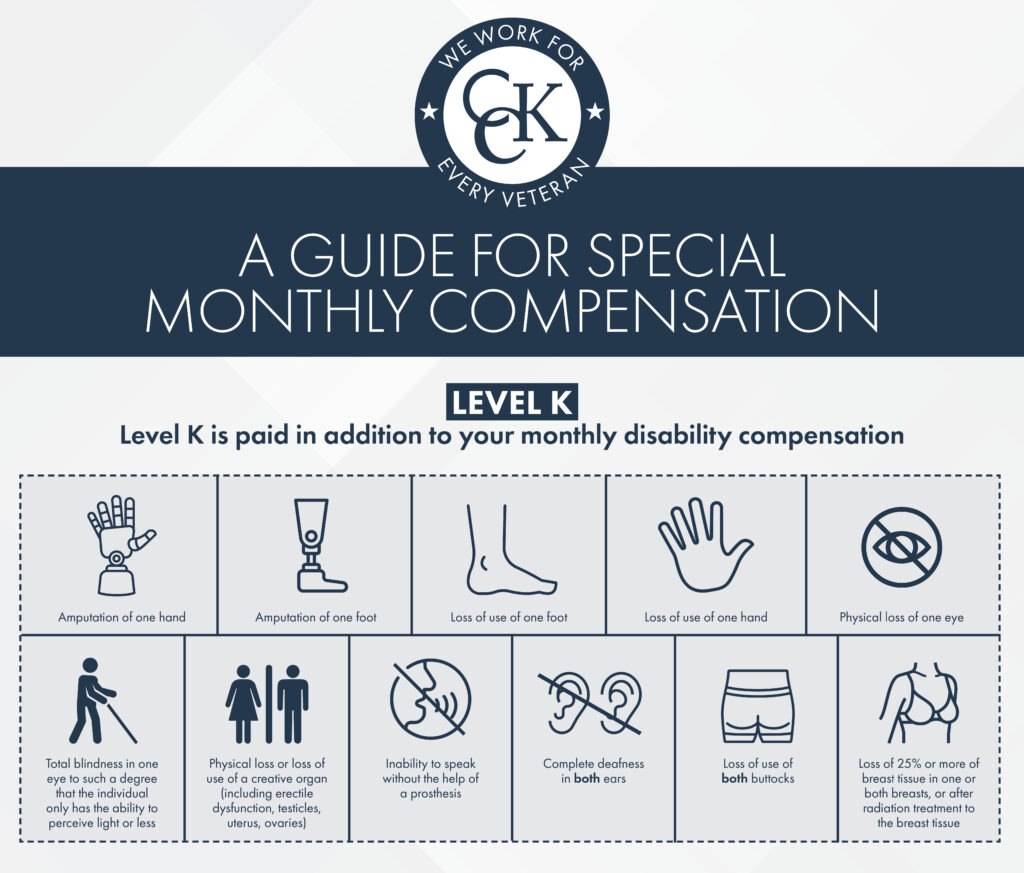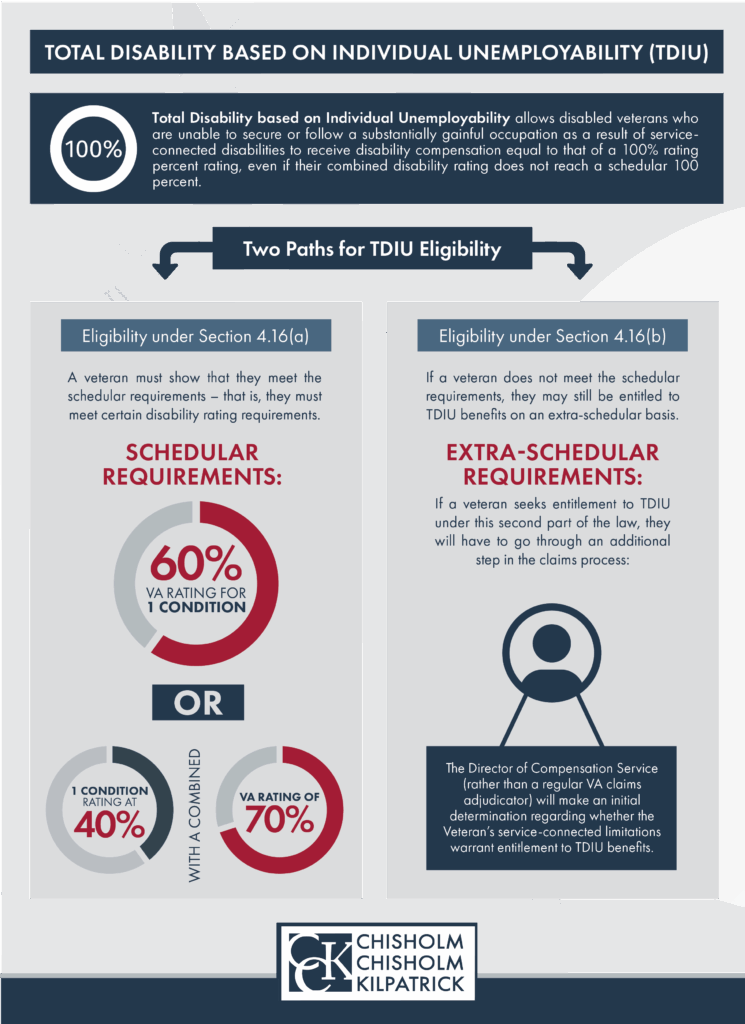VA Disability Benefits for 20 Percent Ratings

CCK Law: Our Vital Role in Veterans Law
A 20 percent disability rating from the Department of Veterans Affairs (VA) entitles a veteran to both monetary compensation and additional benefits. Veterans should research their VA ratings carefully. If the compensation and benefits do not align with their needs, veterans may want to consider one of the several ways to increase their rating.
Highlights of this article include:
- Compensation for 20 percent VA ratings
- Explanations of additional benefits that veterans rated as 20 percent disabled can receive
- Strategies to help veterans increase their 20 percent disability rating
- And more
VA Disability Ratings Explained
VA evaluates service-connected conditions by assigning disability ratings that reflect the nature and impact of a veteran’s symptoms—specifically how often they occur, how long they last, and how severe they are. These ratings are designed to represent the typical loss in earning potential due to a disability.
To be eligible for monthly VA disability payments, a veteran must have a combined disability rating of at least 10 percent. The highest rating available is 100 percent.
Combined VA Disability Ratings, or “VA Math”
It is important to understand that VA uses a unique method for calculating disability ratings when a veteran has multiple service-connected conditions.
For example, suppose a veteran is rated at 20 percent for a back injury sustained during service and 10 percent for PTSD. In that case, those numbers are not simply added together to make 30 percent for the veteran’s final rating.
Instead, VA applies what is known as “VA math”—a specific formula used to combine multiple ratings. This system can be difficult to navigate, which is why CCK Law developed the 2025 VA Disability Calculator to help veterans estimate their combined disability rating more accurately.
VA Disability Pay for 20 Percent Ratings
The core benefit for non-zero (“compensable”) ratings is monetary compensation. It is important to remember that VA compensation benefits keep up with inflation with cost-of-living adjustments (COLA). Note that for 2025, the cost-of-living-adjustment was an increase of approximately 2.5 percent.
For 2025, the 20 percent VA payment rate is $346.95 in base monthly compensation. Note that this amount is not modified by factors like dependent spouses, dependent parents, or dependent children, since the rating itself is too low to qualify.
As of 2025, the VA disability rate benefit amounts are as follows:
- 0 percent disability rating: $0.00 per month
- 10 percent disability rating: $175.51 per month
- 20 percent disability rating: $346.95 per month
- 30 percent disability rating: $537.42 per month
- 40 percent disability rating: $774.16 per month
- 50 percent disability rating: $1,102.04 per month
- 60 percent disability rating: $1,395.93 per month
- 70 percent disability rating: $1,759.19 per month
- 80 percent disability rating: $2,044.89 per month
- 90 percent disability rating: $2,297.96 per month
- 100 percent disability rating: $3,831.30 per month
Special Monthly Compensation (SMC)
Veterans with especially serious disabilities—or a combination of conditions that significantly impact daily life—may qualify for Special Monthly Compensation (SMC). This additional benefit replaces standard monthly disability payments and is designed to help cover extra costs that are not typically addressed by regular VA compensation.
Although a 20 percent disability rating does not reflect a serious enough medical condition to qualify for most types of SMC, there are exceptions. One such exception is SMC-K, which may apply if the veteran experiences loss of use of a reproductive organ.

If a veteran is eligible for SMC-K, they can receive an additional $136.06 per month on top of their existing 20 percent VA disability pay.
To learn more about SMC, check out CCK Law’s article, “Special Monthly Compensation Explained.”
Social Security and 20 Percent VA Disability Pay
Veterans receiving 20 percent VA disability pay might still be eligible for Social Security benefits, depending on the specific program. The two primary types are Social Security Disability Insurance (SSDI) and Supplemental Security Income (SSI).
SSDI eligibility is based on a person’s work history and only considers earned income, which means VA disability payments do not affect your ability to receive SSDI. As a result, it is possible to collect both SSDI and VA disability benefits at the same time.
On the other hand, SSI is a need-based program that factors in all sources of income—including VA disability compensation. For 2025, the monthly income threshold for SSI is $967. Given that veterans with a 20 percent disability rating receive $346.95 each month, they may still qualify for SSI, depending on their full financial picture.
What Other Benefits Do 20 Percent Disabled Veterans Qualify For?
Veterans receiving 20 percent VA disability pay may also qualify for several additional benefits from the Department of Veterans Affairs. These include the following:
VA Health Care Benefits
VA assigns Priority Groups to veterans who apply for enrollment in VA health care. A veteran’s Priority Group also determines whether veterans will be responsible for copayments for medications and different types of care at VA Medical Centers.
If you have a 20 percent disability rating, VA will assign you to Priority Group Three, the third-highest priority group. Priority Group Three does not require copays for inpatient or outpatient care, although it does generally require copayments for outpatient medication.
For example, the following services do not require inpatient and outpatient copays, regardless of the veteran’s Priority Group:
- Care related to a service-connected disability
- Special registry examinations offered by VA to evaluate possible health risks associated with military service (for example, the Agent Orange Registry exam)
- Counseling and care for military sexual trauma
- Compensation and Pension (C&P) examinations
- Care related to VA research projects
- Readjustment counseling
- Care for cancer of the head or neck caused by nose or throat radium treatments received while in the military
- Individual or group smoking cessation, or weight reduction services
- Hospice care
VA also has a health care travel pay reimbursement program to reimburse veterans and caregivers for mileage and other travel expenses to and from approved health care appointments.
Vision Care and Hearing Aids
Veterans who receive compensation for a service-connected condition can also qualify for routine vision and hearing exams and preventative tests. They may also be eligible for eyeglasses and hearing aids. More information about VA’s eyeglasses and hearing aid policy is available on this VA website.

Training Programs Under the Post 9/11 GI Bill
Veterans who received an honorable discharge with a service-connected disability during the right timeframe may be eligible for benefits under the Post 9/11 GI Bill.
This bill offers many training programs to veterans and their dependents. Some of these programs include:
- Entrepreneurship training
- Flight training
- Institutions of higher learning (i.e., undergraduate and graduate degrees)
- Licensing and certification reimbursement
- On-the-job training
- Tutorial assistance
- Vocational/technical training
Veteran Readiness and Employment (VR&E)
Veterans with service-connected conditions rated 10 percent or higher are eligible for VA’s Veteran Readiness and Employment (VR&E) program. VR&E helps disabled veterans and service members increase their likelihood of obtaining employment.
VR&E provides a range of career services, including:
- Career counseling and rehabilitation planning for employment
- Job training
- Job-seeking skills
- Résumé development and other work-readiness assistance
- On-the-job training, apprenticeships, and non-paid work experience
Federal Hiring Preference
When applying for many federal jobs, an eligible disabled veteran can claim a hiring preference on their application or résumé. This awards additional points to the veterans’ score on a civil service exam or application, giving them a higher ranking than non-veteran applicants.
Free Tax Preparation for Disabled Veterans
The IRS’s Volunteer Income Tax Assistance (VITA) and Tax Counseling for the Elderly (TCE) programs assist thousands of veterans in preparing their taxes for free every year.
The IRS works with local community groups to train and certify VITA and TCE volunteers. These volunteers then help qualifying disabled veterans prepare their taxes. VITA and TCE also provide free electronic filing.
Life Insurance for Disabled Veterans
Veterans Affairs Life Insurance (VALife) offers insurance coverage to eligible service members and veterans. Veterans who meet requirements for VALife can receive up to $40,000 of coverage. The premium amount that veterans pay for VALife depends on age and the amount of coverage desired.
Veterans’ Group Life Insurance (VGLI) is a benefit that typically follows Servicemembers’ Group Life Insurance (SGLI), provided the veteran meets certain qualifications, and veterans who continue to pay the premiums for VGLI after leaving service can keep their insurance. Moreover, veterans can receive between $10,000 and $40,000 in life insurance benefits based on the amount of SGLI coverage they had when they left the military.
Burial and Plot Allowance
VA also pays surviving spouses of disabled veterans a flat fee toward burial and plot or interment. This is a change from older policies that require itemization and reimbursement for specific expenses.
The burial allowance for a non-service-connected death is $978, and $2,000 for a death connected to military service. However, the fee varies based on the time and circumstances of death.
State Benefits for 20 Percent Disabled Veterans
In addition to the VA benefits listed above, veterans with 20 percent VA disability ratings may also qualify for state-specific benefits. Some examples of these include free access to state parks, hunting and fishing licenses, and property tax exemptions. To learn more about the benefits offered in your state, read this CCK blog.
How to File for an Increased Rating
There are several circumstances in which a veteran with a 20 percent disability rating may consider attempting to increase their rating. For example, a service-connected condition may worsen, a secondary condition may develop, or a veteran may simply believe that their rating should have been higher based on the severity of their disability.

In these situations, a veteran has several potential options, including:
- File an appeal: Veterans have one year from the date of VA’s initial rating decision to file an appeal. There are three appeal lanes to choose from: (1) Higher-Level Review, (2) Supplemental Claim, and (3) Notice of Disagreement.
- File for an increased rating: Veterans may file an increased rating claim if they are already service-connected for a condition and feel as though it has worsened.
- File for Total Disability based on Individual Unemployability (TDIU): If a veteran’s service-connected condition prevents them from obtaining or maintaining substantially gainful employment, then they may be eligible for TDIU. TDIU provides monthly VA compensation equal to the 100 percent rate. Veterans with a 20 percent disability rating likely do not have a severe enough prognosis to win a TDIU rating, but they can apply for extraschedular TDIU. (See our TDIU infographic below for more information.)
- File for secondary service connection: Veterans who developed another condition as a result of their already service-connected disability can apply for secondary service-connected benefits. This can increase a veteran’s overall disability rating.
Many of these processes can be challenging. Veterans should consider enlisting a VA-accredited veterans law firm for assistance.

CCK Can Help with Your VA Claim or Appeal
If VA denied your claim for disability compensation or you are seeking an increased rating, then Chisholm Chisholm & Kilpatrick LTD may be able to help. The accredited claims agents and attorneys at CCK have decades of experience helping veterans win the disability compensation they deserve.
Call CCK today at (800) 544-9144 or contact us online to schedule a free case evaluation with a member of our team.
About the Author
Share this Post
